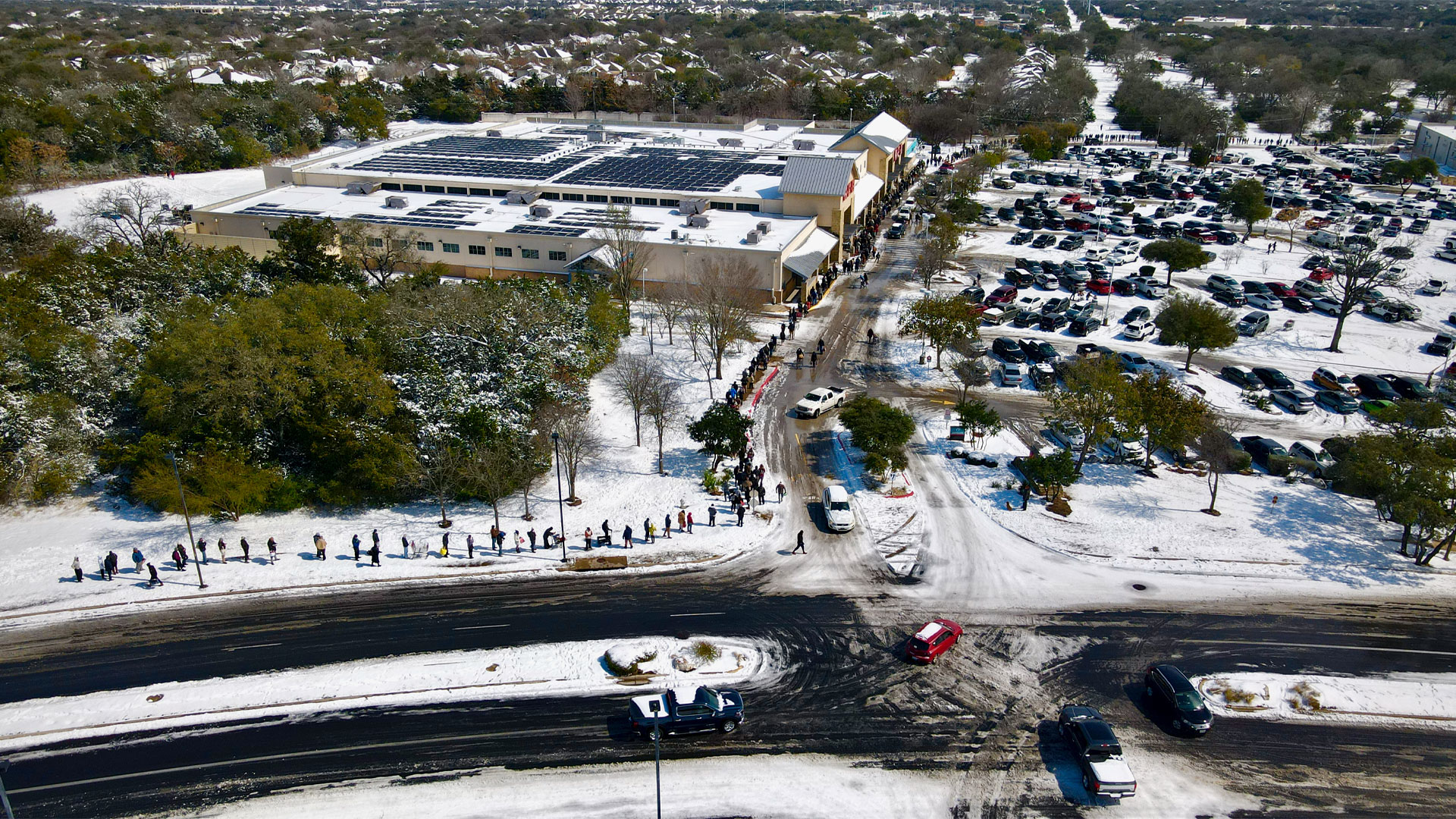Navigating the Texas Grid this Winter
As winter blankets Texas, the challenges confronting our power grid become increasingly apparent. Recent developments unveil pitfalls in ERCOT’s strategies for enhancing power plant capacity, increasing the likelihood of grid failure. In this blog, we’ll delve into the complexities of Texas’ grid, its chances of supporting increased energy demands, and the role of solar energy in fortifying our communities against grid failures and blackouts. Solar offers not just a solution to the problem of growing demand for power, but a sustainable approach for the future of Texas and beyond.

Georgetown, Texas – February 16: shoppers pushing grocery cart and other awaiting in line in front of HEB store after the Texas Blizzard of 2021
ERCOT’s Flawed Winter Preparedness Plan
The Texas power grid operator, ERCOT, aimed to increase the number of power plants in the state this winter by enticing companies to bring some shuttered gas- and coal-fired power plants back online. This was done in an effort to prevent another disastrous power outage like the one Texas witnessed during the winter storm of 2021.
However, these plans faltered when not a single company thought reviving an old power plant made sense, even with costs paid for by ERCOT. That’s because, according to Bloomberg News, it now ‘unequivocally’ costs less to build new renewable energy projects than to operate existing coal plants. Despite ERCOT’s intentions to have more power plants ready for winter, there are concerns that the grid may once again be strained, putting Texans at risk of blackouts.
Probabilities of Grid Failures and Rolling Blackouts
According to a recent Texas Tribune article, the grid faces what ERCOT called an “unacceptable” 20% chance of going into emergency operations if a winter storm like the one that struck last December hits again. Pete Warnken, ERCOT’s manager of resource adequacy, said ERCOT expects the riskiest time for the grid this winter to be 8 a.m. each day, when overnight cold lingers, wind energy may be dying down and the state’s solar energy generation is not at full force.
Warnken estimated the chance for entering emergency conditions at that time on any given day in December was 5%, and the chance for rolling power outages was 4%. Texans are therefore facing the uncomfortable reality of potential disruptions to their daily lives during the upcoming winter months, and residents continue to question the reliability of the state’s power infrastructure.
More Solar Energy in the Mix
While ERCOT’s winter preparedness plan faced setbacks, the article notes an increase in solar energy capacity since 2021. Solar power, along with batteries, can store and quickly deploy electricity into the state’s energy mix. As a renewable and often distributed clean energy source, solar is contributing to the overall energy capacity of Texas, while also creating a more resilient solution to the grid’s challenges.
Grid Resilience
Ed Hirs, an energy market expert and lecturer at the University of Houston, is quoted in the Texas Tribune article expressing skepticism about the efficacy of ERCOT’s plans. He warns that the grid may not be significantly better off, as the state’s coal- and gas-fueled power plants are two years older now, and demand this summer reached new record highs. He cautioned Texans not to accept the probability of emergency grid conditions cited by ERCOT and said, “this is not what we pay them for.”
How Solar Keeps You Prepared
Amidst the uncertainty of grid stability, solar energy emerges as a solution for resilience. Investing in a solar-powered system, complemented by a battery backup, provides peace of mind and ensures that you and your family can weather outages while maintaining comfort and safety. Solar panels generate electricity even during overcast days, and with a battery backup, excess energy can be stored for use during peak demand or emergencies. In addition, when you go solar, you actually benefit the grid as a whole by decreasing demand and easing strain on transmission lines.
Ready to Take the Leap and Go Solar?
In light of the potential grid challenges this winter, a call to action arises. Texas residents and businesses are urged to consider the benefits of solar energy, as going solar not only shields against the possibility of power outages and builds resilience, but also contributes to long-term cost savings. As we encourage the adoption of solar solutions, it’s essential to emphasize the role solar plays in combating the climate crisis. By not producing fossil fuels, the main factor that intensifies extreme weather events like winter storms, solar can help slow down climate change and its effects.
If you’re ready to take control of your power for good and not be dependent on the aged and unreliable Texas grid, it’s time to consider turning your home of business into a solar powerhouse. Our experts here at NATiVE Solar can answer any of your questions, and we can even provide you with a preliminary quote today. Solar is no longer a dream for the future, it’s a solution that’s here to stay. So take the leap, go solar, and #TakeYourPowerBack with NATiVE Solar!

































Leave A Comment